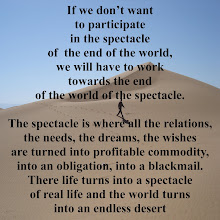Friday 14 January 2011 -- After a dramatic 24 hours when Tunisia's dictator president Ben Ali first tried promising liberalisation and an end to police shootings of demonstrators and then, this evening at 16:00, declaring martial law, he has finally fallen from office. While the rumours are still swirling, one thing is clear, Ben Ali has left Tunisia and the army has stepped in.
Monday, January 24, 2011
"Tunisia: Multitude in Revolt" from Moment of Insurrection
intro about the revolt in Tunisia
by Workers Solidarity Movement:
Friday 14 January 2011 -- After a dramatic 24 hours when Tunisia's dictator president Ben Ali first tried promising liberalisation and an end to police shootings of demonstrators and then, this evening at 16:00, declaring martial law, he has finally fallen from office. While the rumours are still swirling, one thing is clear, Ben Ali has left Tunisia and the army has stepped in.
The day began with a mass demonstration called by Tunisia's trade union federation, the UGTT, in the capital Tunis. Between 10 and 15,000 people demonstrated outside the Ministry of the Interior. The initially peaceful scene broke down at around 14:30 local time as police moved in with tear gas and batons to disperse the crowd, some of whom had managed to scale the Ministry building and get on its roof. From then on, the city centre descended into chaos with running battles between the riot police and Tunisians of all ages and backgrounds fighting for the overthrow of the hated despot.
Finally, armoured cars from the army appeared on the street and a state of emergency and curfew was declared with Ben Ali threatening the populace that the security forces had carte blanche to open fire on any gatherings of more than three people. Soon, however, he disappeared from view and the rumours began to circulate. The army seized control of the airport and there were reports of convoys of limousines racing to the airport from the Ben Ali families palace. Finally the official announcement came. Ben Ali is gone. Prime Minister Mohammed Ghannouchi appeared on state TV to announce that he was in charge of a caretaker government backed by the army.
Tonight the long-suffering people of Tunisia may rejoice that their last four weeks of heroic resistance has finally seen off the dictator who ran the most vicious police state in North Africa over them for the last 23 years.
But tomorrow morning will find the army in charge. What will happen tomorrow and the days to follow is anybody's guess. But the people now know that they have the power to overthrow a long-entrenched dictatorship, how much easier to take on a new unstable regime.
Report by Workers Solidarity Movement
find more info, videos and reports here:
"Tunisia: Multitude in Revolt" from Moment of Insurrection
Revolt of the multitude
The situation in Tunisia is a rupture brought into being by the militancy of the multitude. There is no party or leadership, no unions or even a class that has forced this situation – rather, it is a multitude. The multitude defined not as the people, not a mass, not as a set of individuals. It is defined as a network of singularities, where these singularities – in order not to become reduced to chaos – recognize themselves in a common that extends beyond them. The intensity with which power is being swarmed by the multitude clearly articulates the militant position. The fact that the hole blown wide open has not been filled by oppositional political stand-ins, or suppressed by military might shows the potential flight this situation is in the process of becoming – the reproduction of the insurrectionary situation that brings into being a maximally revolutionary event that until such rupture did not exist, and in fact seemed impossible just prior (–‘it could never happen in Tunisia’). It was not a chance taken within a revolutionary situation, but rather a militant movement imposed upon a reality that believed itself to be impenetrable (–Tunisia over the last couple days has been described by media as having been both ‘the most modern African state’ and consequently, ‘a totalitarian police state’). This moment of insurrection is not static and can swing in any direction or reaction; the nation-state of Tunisia and the histories of those breaking free from it, outline such potentialities.
Carthage is burning!
The product of an ancient lineage of foreign occupation, Tunisia was first colonized by the Roman Empire in 146 BC. The Arab invasion in the 7th century lasted until 1882 when the Europeans fought it out amongst themselves for control which finally ended in French domination. In 1942 the Nazis took over until finally ousted by a popular nationalist movement that was subsequently able to kick out the French in a campaign of armed struggle between the years of 1952-55. This ushered in the on-going reign of neo-colonialism. The party that controlled Tunisian society and imprisoned the indigenous populations within its borders has undergone a number of name changes and even flirted with ideological deviations including mass collectivization of land and nationalization of industry, as well as support for Palestinian resistance. The socialist facade dissolved in the toxic dumping of liberalism in the 70’s – which in turn unleashed waves of mass revolt that left dozens dead in the rioting which mirrors the images being transmitted from Tunisia today. In reaction to the popular unrest a new prime minister was imposed in 1980 and implemented the apparatus of fascistic control that is now being torn asunder. In a decade-long exchange of blows between the state and society – in which the state resorted to the mass imprisonment and killings – Ben Ali (last seen running for his life) was crowned under the latest party handle: the Democratic Constitution Rally. He went on to solidify his position by further negating hard fought rights and banning most oppositional parties. It is this process that returns the rupture of revolt.
Social war against empire
The multitude that now holds the popular position is not unfamiliar with the reoccurrence of domination under the various guises of counter-revolution. The success of the revolt thus far has been its assemblage of tactics and strategy which deterritorialze the urbanism into smooth space. This in turn ensures the movement’s agility in the streets, its velocity in concentration of power and dispersal of forces, its unity of mass and transmogrification of attack. Conducted dually with the mobilizations of popular power has been the rearguard battles fought out with rocks, burning barricades and armed struggle. Without the communal-militarization of the social unrest, the state’s military and police forces would have succeeded in putting down the upheaval as they had before on several occasions. And that crux is now the major theatre of operations – currently being conducted within the state of emergency: the armed communization of the multitude, who behind their barricades are defending their territory from the forces of command– the police, army, politicians and death squads who are at the behest of empire, in the dire attempt to ‘regain order’.
Further underlining the mode of the multitude is the reality of the total social upheaval. That society has been subsumed by capital throughout empire is met in consequence by the configurations of the multitudes revolt. A social war not isolated to any one contradiction; where all antagonisms are played out over the entire social terrain– not confined to the workplace or parliaments, and thereby unable to be institutionally mediated in isolation. The social war that is revolutionizing society in Tunisia has its equal force throughout the planetary upheavals now rupturing empire in a global civil war. In the bordering nation-state of Algeria the rocks are hurled and barricades built with the might and subjectivity of the same multitude, which disperse along the similar lines of flight that are transversed through that region by the millions of nomadic people who have for millennia been at war.
Nomad War Machine
Within the fortress state of Tunisia, convoys of ‘Imazighen’ (free people) make their way through the southern lands. The Bedouin and Berbers and nomadic and have violently fought off state appropriation. ‘The war machine is that nomadic invention that in fact has war not as its primary object but as its second-order, supplementary or synthetic objective, in the sense that it is determined in such a way as to destroy the State-form and city-form with which it collides.’ As many nomads have been economically forced to migrate to the cities as wage-slaves, we can assume that the tendencies of the nomadic war machine have been recommunized there – the necessity to flee from the state, but while doing so, grabbing a weapon.
Exodus
It is in this exodus from the state apparatus that the Tunisian multitude-in-motion must continue. The popular power in the streets has left power in the gutter, can it be gathered and used to smash the state, or will it be re-conquered by empire now circling overhead? At the height of unrest the prisoners in many prisons across Tunisia knew how it must be done, they did not wait for the political outcome, but forced their way through the concrete walls of reality. In one case a fire set during the prison revolt led to the mournful killing of many insurgents shot whilst fleeing the flames; in other prisons they escaped by forcefully taking control. Without being able to rely upon the forces of command, now bunked down in the street fighting – the prison guards were in no position to defend the institution and the prisoners walked out. It is our hope that they are able to return to destroy the prisons once and for all. It is our desire to do the same here.
article originaly published here:
Subscribe to:
Post Comments (Atom)




















No comments:
Post a Comment